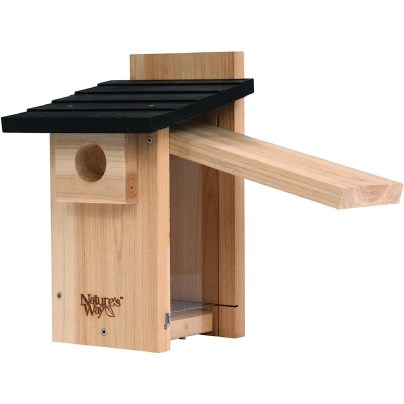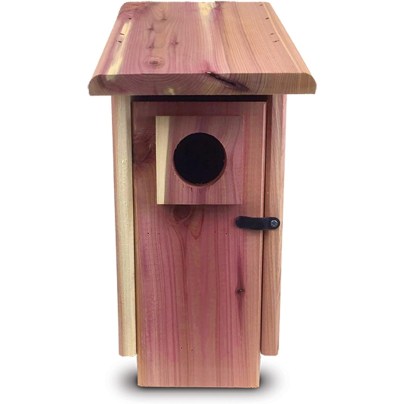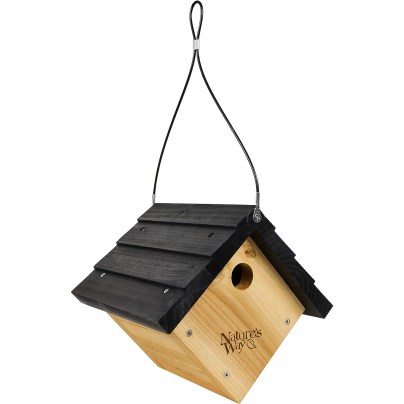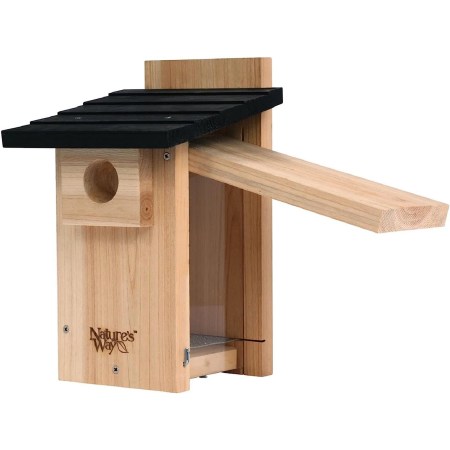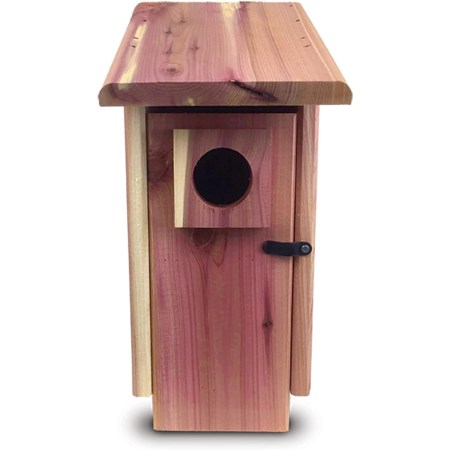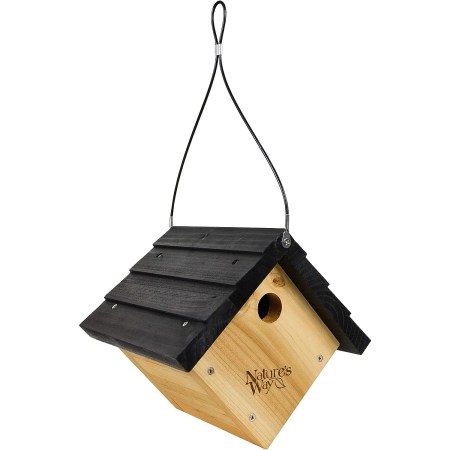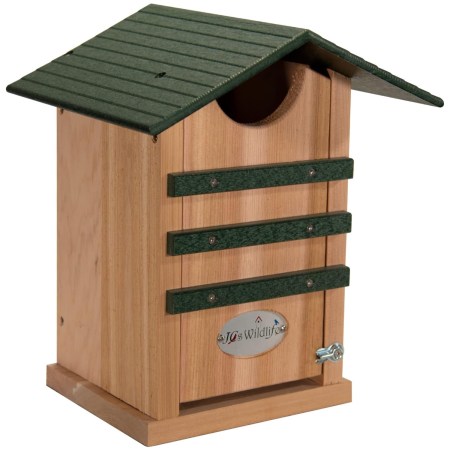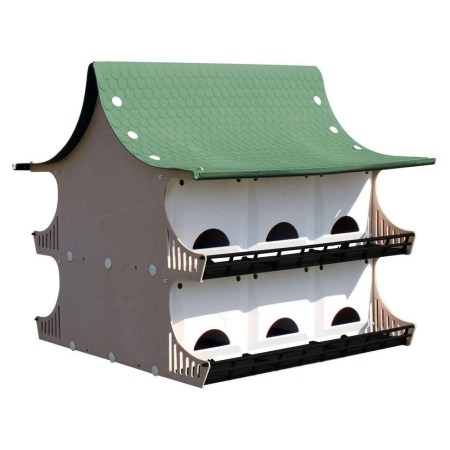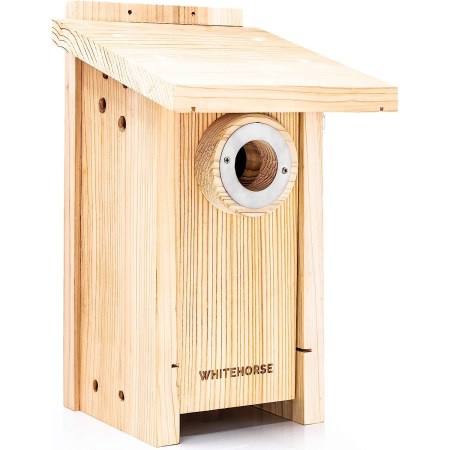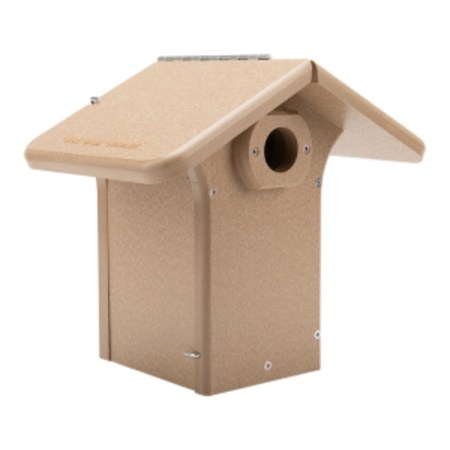We may earn revenue from the products available on this page and participate in affiliate programs. Learn More ›
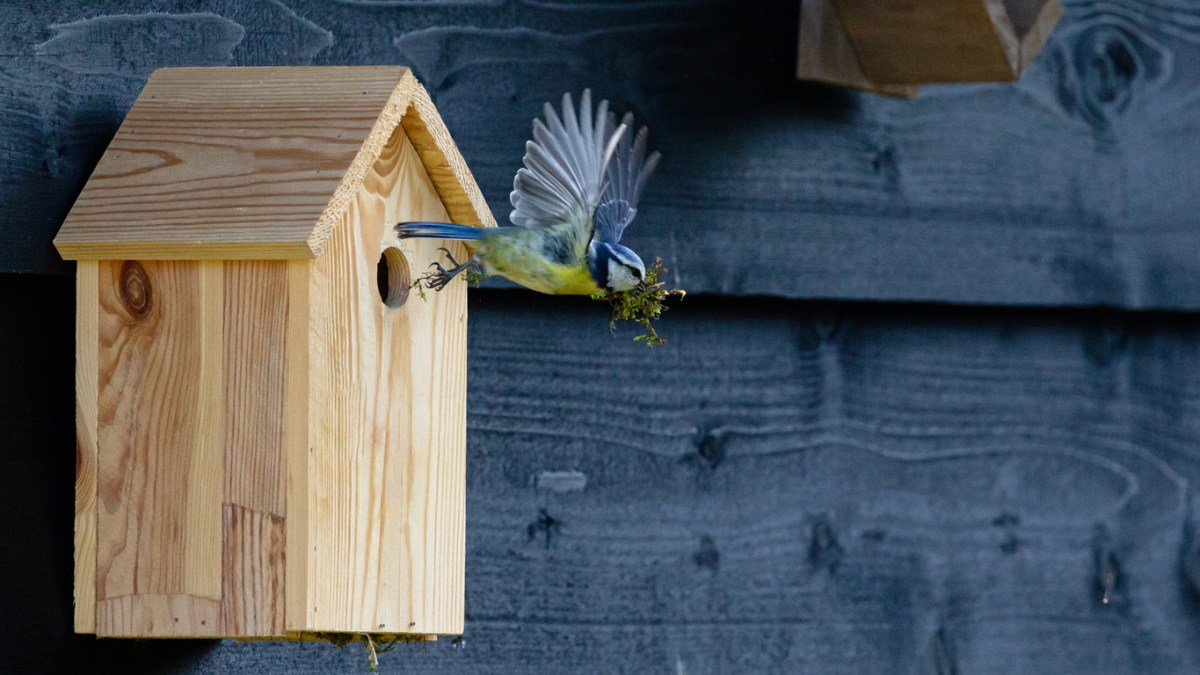
Birdhouses can make a garden more inviting to both birds and humans. They look charming, and the right one will attract birds and make a yard feel lively. For bird lovers, there are few things more rewarding than providing a quaint home for a bird family.
Not all birds use birdhouses—only some species of cavity-nesting birds do. Some birds that will happily use birdhouses and nest boxes include chickadees, bluebirds, finches, sparrows, martins, swallows, thrushes, woodpeckers, and wrens, and each bird type has its own preferences. There’s no single best birdhouse for every type of bird, so we explain some features to consider ahead. Read on for the practical and attractive best birdhouses that will appeal to a range of backyard birds.
- BEST OVERALL: Nature’s Way Bird Products Bluebird Box House
- BEST BANG FOR THE BUCK: Pennington Cedar Birdhouse
- BEST FOR WRENS: Nature’s Way Bird Products Traditional Wren House
- BEST FOR OWLS: JCs Wildlife Cedar Screech Owl Nest Box
- BEST FOR PURPLE MARTINS: S&K Manufacturing 12-Family Purple Martin Birdhouse
- BEST WEATHER-RESISTANT: Whitehorse Birdhouse
- EASIEST TO CLEAN: Wild Birds Unlimited EcoTough Bluebird Nesting Box
How We Chose the Best Birdhouses
The best birdhouses are safe and bird-friendly, which often means they have plain designs that aren’t particularly eye-catching. This doesn’t mean they’re unattractive, but colorful picks with perches are generally out—they’re just not the best choice for most birds.
The birdhouses on our list are well constructed, made using untreated wood (with one exception). They have thick enough walls to keep birds comfortable as well as features to prevent water problems (such as a sloped roof and ventilation and drainage holes). In other words, they’re designed to keep little birds safe.
Each bird species has different preferences—after all, bird types from house wrens to screech owls can use birdhouses. To suit these differences, we included a range of birdhouse types and sizes on our list, so there should be a pick here that works for most gardens.
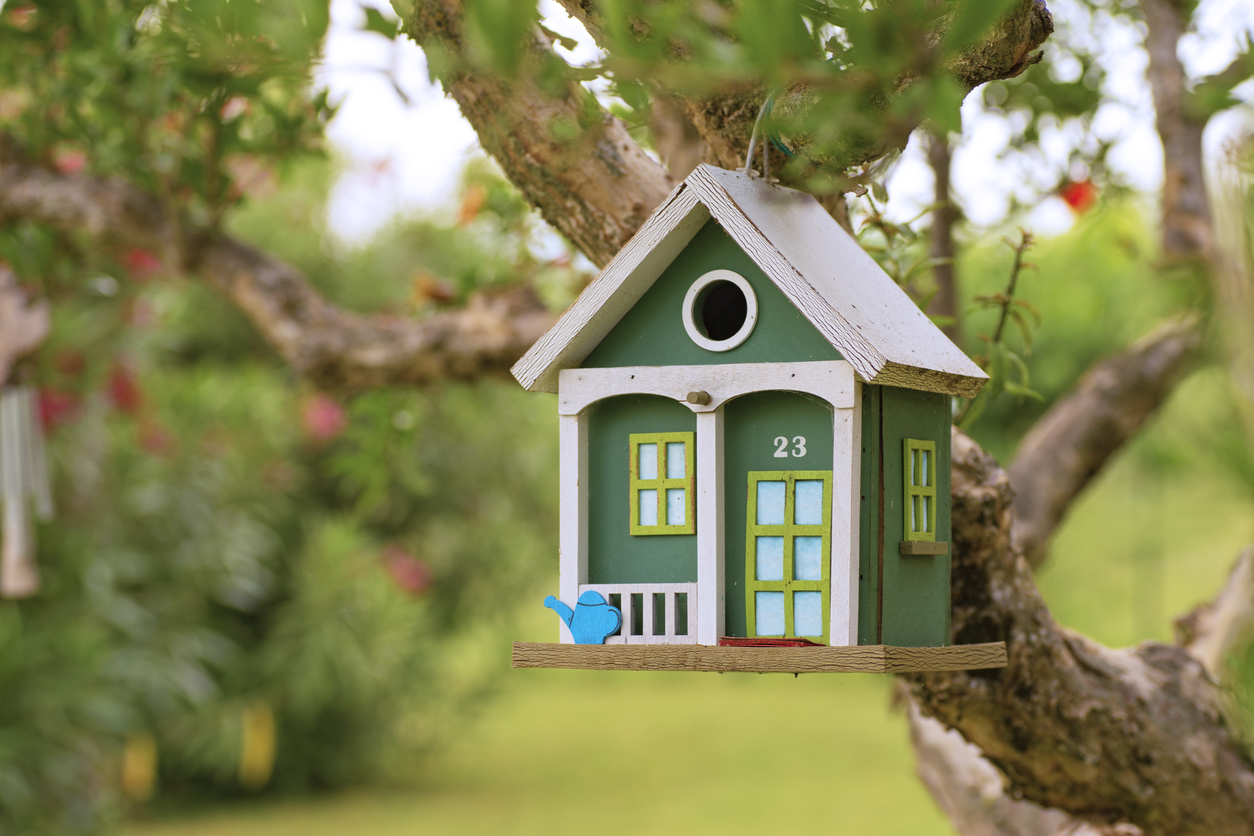
Our Top Picks
Hoping to welcome a feathered family? Become the best bird landlord on the block with the top birdhouses ahead.
Best Overall
Nature's Way Bird Products Bluebird Box House
See ItThe Nature’s Way Bird Products bluebird box house is made with both birds and humans in mind. This birdhouse is designed for bluebirds, but it will also attract tree swallows, chickadees, nuthatches, titmice, and wrens. It’s made of insect- and rot-resistant cedar, held together with rust-free stainless steel screws, and finished with a safe water-based protective stain.
This birdhouse has a few design elements that make it an excellent home for birds. It has air vents and kerfs below the entry hole, which provide extra grip for baby birds to climb out. An elevated mesh floor helps prevent certain pests, while a predator guard protects the 1½-inch entrance from intruders.
In terms of human-friendly features, a clean-out door on one side of this birdhouse offers easy access for cleaning. This side also has a clear and crack-resistant viewing window, which gives you visual access to birds inside. Nature’s Way also sells a similar birdhouse without a viewing window (and for a slightly lower price).
Product Specs
- Material: Cedar wood
- Dimensions: 12 inches tall by 7½ inches wide by 8⅛ inches deep
- Hole size: 1½ inches
Pros
- Well-built birdhouse made with natural cedar, rust-resistant screws, and weather-resistant design
- Includes a built-in predator guard at the entry hole to help dissuade potential intruders
- Has a user-friendly clean-out door and viewing window on 1 side
Cons
- The black roof might heat up the birdhouse too much in some climates
Get the Nature’s Way Bird Products bluebird birdhouse at Amazon, Walmart, Blain’s Farm & Fleet, or Nature’s Way.
Best Bang For The Buck
Pennington Cedar Birdhouse
See ItBird-watching is an affordable hobby, and one inexpensive way to attract more birds is by setting up a budget-friendly birdhouse. The Pennington cedar birdhouse fits the bill, with a reasonable price tag but a sturdy design. It’s made of red cedar wood, which is naturally resistant to insects and wet weather.
This is another relatively small birdhouse that makes an ideal home for Eastern bluebirds. To keep birds happy and safe, it has ventilation and drainage openings, as well as a built-in predator guard guard at the 1 9/16-inch entrance. Mounting hardware is also included with this birdhouse. When the nesting season is over, hinge the front panel open to clean it out.
Product Specs
- Material: Cedar wood
- Dimensions: 12¾ inches tall by 5¾ inches wide by 6⅞ inches deep
- Hole size: 1 9/16 inches
Pros
- Affordable price for a sturdy and attractive cedar wood birdhouse
- Has a built-in predator guard to protect little birds from intruders
- Comes fully assembled and includes mounting hardware for flush or pole mount
Cons
- The front panel does not open all the way, which can impede installation and cleaning
Get the Pennington birdhouse at Amazon, Chewy, or Pennington.
Best For Wrens
Nature's Way Bird Products Traditional Wren House
See ItCompared to other birds, wrens aren’t terribly picky about their nesting sites and are one of few species that tolerate a hanging birdhouse. A hanging birdhouse can be easier to install and can add some visual interest in gardens with several birdhouses (providing an alternative look to mounted birdhouses). They also have some benefits for wrens—hanging birdhouses are harder for predators to get to.
This hanging birdhouse from Nature’s Way is made from insect- and rot-resistant cedar and rust-resistant hardware with a sturdy vinyl-coated steel hanging cable. It has air vents along the wall and floor to improve ventilation and drainage. A small 1⅛-inch entry hole allows wrens to fly in and out but is too small for sparrows and other larger birds to gain access. A clean-out door on one of the bottom sides makes the interior easy to clean at the end of the season.
Product Specs
- Material: Cedar wood
- Dimensions: 8 inches tall by 8⅞ inches wide by 8⅛ inches deep
- Hole size: 1⅛ inches
Pros
- Hanging design is suitable for wrens and provides extra protection from predators
- Clean-out door on bottom side provides easy access for tidying up
- Vinyl-coated steel hanging cable is sturdy and long lasting for a tree branch
Cons
- Some reviewers report cracked or detached roof piece
Get the Nature’s Way Bird Products wren birdhouse at Amazon, Walmart, Blain’s Farm & Fleet, or Nature’s Way.
Best For Owls
JCs Wildlife Cedar Screech Owl Nest Box
See ItOwls can make entertaining backyard companions, and the right birdhouse will attract them and keep them around. The JCs Wildlife cedar screech owl nest box is suitable for screech owls and saw-whet owls. Made of cedar wood and with a recycled poly lumber roof, it’s built to withstand the elements and keep owls cozy.
Air vents and drainage help keep the environment pleasant inside this birdhouse, and both interior and exterior slats help owls enter and leave the birdhouse. This nesting box is people-friendly as well, with a front panel that opens for simpler cleaning. To set bird lovers up for their first year of use, nesting materials and mounting screws are included with this birdhouse.
Product Specs
- Material: Cedar wood
- Dimensions: 11¾ inches tall by 7¾ inches wide by 7½ inches deep
- Hole size: 3 inches tall by 4 inches wide
Pros
- Recycled poly-lumber roof can withstand wet conditions with less risk of splitting or cracking
- Built-in interior and exterior slats help owls enter and exit the birdhouse
- Comes with nesting materials and mounting hardware for instant use
Cons
- Some users found this birdhouse difficult to mount
Get the JCs Wildlife birdhouse at Amazon, Walmart, or JCs Wildlife.
Best For Purple Martins
Su0026K Manufacturing 12-Family Purple Martin Birdhouse
See ItPurple martins are one of few bird types that prefer communal housing. Their birdhouses come in apartment-style designs, with individual homes in a communal layout. They also don’t need to be made of wood—thick plastic, aluminum, and natural gourds are all appropriate as well.
The S&K Manufacturing 12-family purple martin birdhouse is made of ultraviolet-protected plastic. Most importantly, it’s painted white, which helps reflect heat and keep the house cool inside, a necessity for purple martin housing. It also has a charming design, with a landing and take-off rail that looks like a quaint porch around the birdhouse.
One birdhouse has enough space for 12 purple martin families, with 12 compartments that each measure 6 inches long by 6 inches wide. The compartments can be expanded to 6 inches long by 12 inches wide for those who want to offer the birds more space.
Product Specs
- Material: Plastic
- Dimensions: 21 inches tall by 20 inches wide by 21 inches deep
- Hole size: 2¼ inches
Pros
- Well-designed birdhouse for purple martins; weatherproof plastic material that’s painted white
- Supports communal living, which is preferred by purple martins
- Charming design looks like a white cottage, including porch that doubles as a perch
Cons
- Necessary mounting pole must be purchased separately
Get the S&K Manufacturing birdhouse at Amazon, Walmart, or S&K Manufacturing.
Best Weather-Resistant
Whitehorse Birdhouse
See ItA number of smart design features makes the Whitehorse birdhouse more weather-resistant than most. A large single-piece slanted roof with a roof kerf channels rainwater away from the birdhouse. It has vent holes, which are cut at an upward angle to keep water from dripping in. Drainage holes, a recessed and sloped floor, and wind- and rain-resistant joints keep the nest dry.
This birdhouse is made of cedar wood. The 1½-inch entry includes a predator guard and an additional stainless steel guard, which both help prevent animals from enlarging or entering the hole. It’s the right size to attract eastern bluebirds, titmice, chickadees, and nuthatches. The company also sells a larger version that attracts bluebirds, tree swallows, and other species.
Product Specs
- Material: Cedar wood
- Dimensions: 12¾ inches tall by 7¾ inches deep by 7¾ inches wide
- Hole size: 1½ inches
Pros
- Overhung roof, upward-drilled vent holes, and weatherproof joints prevent rainwater from getting inside
- Drainage holes and a recessed and sloped double-floor help keep the nest dry
- Features a predator guard with a stainless steel piece for extra protection
Cons
- Some reviewers note sparrows inhabiting the box, which some birders might not find ideal
Get the Whitehorse birdhouse at Amazon.
Easiest To Clean
Wild Birds Unlimited EcoTough Bluebird Nesting Box
See ItA unique two-way opening design makes the Wild Birds Unlimited EcoTough bluebird nesting box easy to clean. This birdhouse opens on one side, as well as on the roof of that same side, to make it simple to view the nest inside and clean it thoroughly at the end of a season. Ventilation and drainage features help to keep nests dry in the meantime.
Designed for bluebirds, this birdhouse has a 1½-inch entry hole. While this birdhouse is made of recycled plastic, its walls are thick enough to provide some insulation, plus it won’t be as prone to rotting or cracking as wood.
Product Specs
- Material: Recycled plastic
- Dimensions: 11¾ inches tall by 8¼ inches wide by 10¾ inches long
- Hole size: 1½ inches
Pros
- 2-way opening system opens at roof and along side for easy cleaning
- Made of thick recycled plastic that won’t warp or rot from moisture
- Predator guard around entry hole helps to dissuade intruders
Cons
- Some birders might not like the plastic material and may prefer traditional wood instead
Get the Wild Birds Unlimited birdhouse at Wild Birds Unlimited.
Or, DIY Your Own Birdhouse
Wood is the material of choice, especially for DIY birdhouses. Wood is easy to work with, plus it’s the ideal material for housing most birds. Making a birdhouse essentially involves creating a four-walled house out of wood with a front entrance hole and slanted roof. Choose the house dimensions and entry hole size depending on the bird type, since each bird species has different needs.
Regardless of bird type, proper ventilation and drainage are key. A slanted roof is best because it allows rainwater to run off without pooling. A few small holes just beneath the roof can let air in—just make sure that the roof extends over the walls of the birdhouse so rainwater can’t make its way inside. Small holes on the floors near the corners or walls will help with drainage.
There’s no need for a perch on a birdhouse. Birds don’t need them to get in and out of the house, and they can actually pose a hazard since they can help predators gain access. Find step-by-step details on how to make a birdhouse here or by following one of these birdhouse plans.
Jump to Our Top Picks
What to Consider When Choosing a Birdhouse
Choosing a birdhouse isn’t as easy as picking the prettiest one and hanging it in a tree. While this method works for decorative purposes, it won’t necessarily attract birds. To choose nest birdhouses that are bird-friendly, consider the intended bird type, birdhouse dimensions and hole size, and material.
Bird Type
With preferences varying wildly from species to species, bird type is the most important factor to consider when choosing the best birdhouse for a yard. Many birds prefer single birdhouses since they are somewhat territorial and want their homes to be far enough away from other birds. This is not always the case though. For example, purple martins like to live in apartment-style birdhouses with others of their kind.
The bird type and size plays a major role in choosing the birdhouse dimensions and hole size, which we explore ahead. Consider the intended bird type and choose a birdhouse style accordingly. For shoppers who don’t know much about birds, NestWatch has a helpful tool to determine bird types and what to look for in a suitable birdhouse based on region.
House and Hole Size
Cavity-nesting birds would usually make their home in the cavity of a tree. Of course, the size of the bird plays a huge role in the ideal house size. Generally, small birds will prefer small houses and large birds large houses. Around 5 inches long by 5 inches wide at the base is a good size for many species, and most like an overall height of around 10 inches. Increase the dimensions for larger birds, like the northern flicker, and double them for wood ducks and screech owls, opting for a birdhouse around 10 inches long by 10 inches wide at the base and around 20 inches high.
The entry size also matters. It needs to be large enough to let the bird comfortably enter and exit, but not so large that it lets predators and other uninvited guests in. The ideal hole size depends on the bird species. For example, many songbirds like a 1½-inch entry hole; wrens like a smaller 1⅛-inch entry hole, and larger birds will need a bigger hole. Ultimately, the best way for shoppers to find both the ideal birdhouse and entry hole size is to search recommendations for the specific bird species they are trying to attract. Birdhouse dimension charts are available as a helpful resource.
Materials
Most birds prefer materials that mimic their natural environment. This means untreated wood is almost always best. The birdhouse’s walls should be at least ¾ inch thick to help insulate the inside of the box. Unfinished wood has a rougher texture that helps give baby birds a foothold when they need to make their way to the opening. This is why an unfinished interior is best.
If paint is needed, apply it only to the exterior. While a brightly painted birdhouse might look pretty, it might not get the most use. Many birds tend to prefer earthy tones that blend into the environment. They also tend to prefer weathered birdhouses, which is one reason why birds might not take up house in the first season of a new birdhouse, but may choose to dwell there after a couple of years when the birdhouse looks more worn.
Tips for Attracting Birds to a Birdhouse
Just like any other animal, birds want to have their basic needs met. That means making the garden an attractive place for birds to live, with suitable food, water, and shelter sources.
Choosing the right birdhouse is an important first step, but it also is important to place the birdhouse in a location that appeals to the species. This means choosing a spot according to the bird type (some prefer open spaces, while others birds want to nest in a thicket) and making sure to place the birdhouse high enough off the ground and far enough away from places where predators might have easy access. As a general rule, don’t place birdhouses too close to bird feeders or bird baths. The locations of bird feeders and bird baths are high-traffic areas, so they’re not ideal for birds (especially those raising young ones) to live right next to.
Consider setting up a few different types of birdhouses to attract different species. Not every birdhouse will be successful in attracting a bird family each year, so having more birdhouses in the landscape offers more chances, but don’t crowd them too closely together. This will also help improve bird diversity and provide housing for birds in areas where there may be habitat loss.
- Make the yard or garden more attractive to birds by having bird feeders and bird baths
- Choose an appropriate birdhouse location depending on the bird type
- Don’t place birdhouses too close to bird feeders and bird baths
- Variety can help: Set up a few different types of birdhouses
FAQs
There’s more to choosing a birdhouse than just picking a pretty design—often the most eye-catching, colorful birdhouses actually aren’t the best for our feathered friends. The easiest way to choose the best birdhouse is to figure out what species you want to attract and work from there. We’ve rounded up some frequently asked questions about birdhouses to help you get started.
Q. Which birdhouses attract which birds?
It really depends on what type of bird you’re trying to attract—for example, the birdhouse needs of bluebirds are different from those of screech owls. To figure out what type of birdhouse to buy, start by narrowing down the bird types you want to attract. The Nest Watch Right Bird, Right House tool can help you figure out the birds in your area and the best type of birdhouse for each species.
Q. What material is best for birdhouses?
Unfinished wood is the best material for birdhouses—it closely mimics where cavity-nesting birds would nest in the wild (usually inside tree cavities) and is free of possible contaminants that can harm sensitive birds.
Q. Where should you put a birdhouse?
The birdhouse location depends completely on the bird species. Some birds like to nest lower to the ground, others near open spaces, and others in thickets of brush. Install the birdhouse according to the species’ preferences. Many birdhouses will come with directions for the ideal installation location.
Q. How do you protect a birdhouse?
When you have a fledgling bird family, the last thing you want is any harm to come to them. There are several ways to protect a birdhouse, and the first starts with location. Make sure to mount a birdhouse at the right height—within the preferred range recommended for the bird species while also resting high enough to prevent predators. In addition, mount a birdhouse far enough away from fences, posts, and other items that predators can use to climb up to the birdhouse. Adding extra intruder-preventing measures like predator guards and baffles can further help dissuade animals.
Q. What color birdhouses do birds like best?
Birds prefer birdhouses that blend into the natural environment, so wooden birdhouses in natural brown and green shades are preferred.
Why Trust Bob Vila
Bob Vila has been America’s Handyman since 1979. As the host of beloved and groundbreaking TV series including “This Old House” and “Bob Vila’s Home Again,” he popularized and became synonymous with “do-it-yourself” home improvement.
Over the course of his decades-long career, Bob Vila has helped millions of people build, renovate, repair, and live better each day—a tradition that continues today with expert yet accessible home advice. The Bob Vila team distills need-to-know information into project tutorials, maintenance guides, tool 101s, and more. These home and garden experts then thoroughly research, vet, and recommend products that support homeowners, renters, DIYers, and professionals in their to-do lists.
